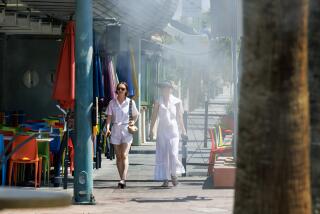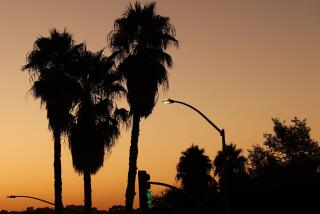Heat Wave: Death Valley hits 128 degrees -- or is it 129?
- Share via
FURNACE CREEK--Blame it on dueling thermometers.
The National Weather Service thermometer recorded a peak temperature at 4 p.m. Sunday of 128 degrees in Death Valley National Park, which ties the record for the hottest June day anywhere in the U.S.
The National Park Service thermometer – 200 yards away – recorded a temperature of 129.9, which shatters the record for June.
But the National Weather Service has the final say, and its official electronic readings will not be available until 8 a.m. Monday.
“There’s only one thermometer that counts,” said Charlie Callagan, the park’s wilderness coordinator and former head of its weather station. “There’s a possibility that we actually broke the record for June, and that’s exciting.”
That kind of talk disappointed dozens of visitors who had gathered at the park’s headquarters expecting to learn that they had sweated through a historic high on Earth.
After all, many of them had taken informal readings from thermometers at popular destinations throughout the park, all of them different and ranging from 128 to 132 degrees and above. Those thermometers include a large digital model prominently displayed at the entrance of the headquarters.
That thermometer was showing off temperatures above 130 degrees for much of Sunday afternoon, attracting hundreds of visitors who posed for photographs next to what they thought were historically high numbers on the screen. Park rangers, however, sheepishly apologized later for what they described as errant figures on a device they described as no more than “a photo-op for tourists” and not the official measuring instrument.
Meteorologists had expected the mercury to soar to about 130 degrees for the first time anywhere in the country in nearly a century. The highest temperature ever recorded on Earth is 134 degrees, recorded in Death Valley on July 10, 1913.
Meteorologists attribute the crippling heat to a combination of factors, including a relatively narrow valley bordered by mountain ranges that trap prevailing winds and curtail circulation, a dearth of vegetation, vast expanses of sand, dirt and rocks that heat up in the summer sun, the region’s low elevation and global warming.
The national park’s headquarters in Furnace Creek is 190 feet below sea level. Nearby Badwater, at 280 feet below sea level, is the lowest spot in the Western Hemisphere.
Meanwhile, the entire Southern California region was experiencing extreme temperatures.
In Los Angeles, the heat was a particular concern to firefighters because it comes in a year of record dry conditions that have already sparked several major brush fires in the area.
Fireworks also went on sale Friday in some areas, adding another fire danger. Fireworks will be sold in 295 designated communities in the state through the Fourth of July.
Since January, the California Department of Forestry and Fire Protection has responded to about 2,900 fires, department spokesman Daniel Berlant said. In an average year, he said, it would have responded to fewer than 1,800 by this time.
Dry brush is a reason for the increase in fires, Berlant said. Current weather conditions are more typical of late August or early September, he said.
Several agencies opened cooling centers — air-conditioned facilities where the public can escape the heat — in Los Angeles County. For information about the centers, call 211.
ALSO:
Officers kill suspect in gun battle in Pacoima, police say
In San Francisco, a weekend of gay weddings at City Hall
L.A. voters mostly upbeat as new mayor Eric Garcetti starts his job
More to Read
Sign up for Essential California
The most important California stories and recommendations in your inbox every morning.
You may occasionally receive promotional content from the Los Angeles Times.











